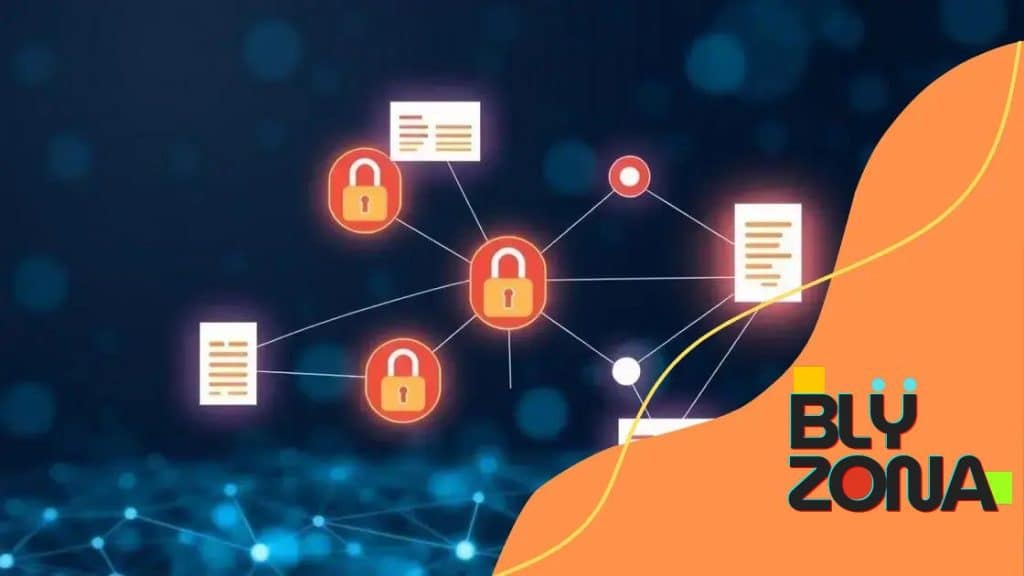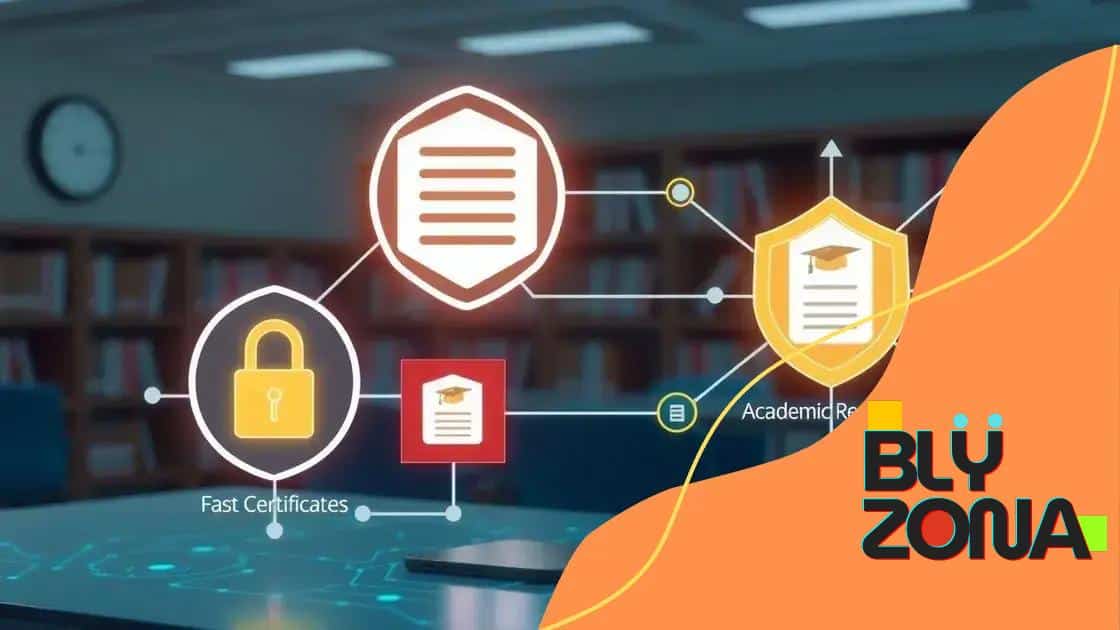Blockchain securing lifelong learning records

Blockchain technology secures lifelong learning records by providing immutable and verifiable credentials, enhancing trust and accessibility in education while facilitating personalized learning paths and global access.
Blockchain securing lifelong learning records is changing the way we verify educational achievements. Imagine having a tamper-proof record of every skill you’ve acquired throughout your life. This article delves into how blockchain is paving the way for a new era of trust in education.
Understanding blockchain technology
Understanding blockchain technology is essential for grasping its impact on various sectors, especially education. This technology offers a new way to securely store and share information. By utilizing a decentralized network, blockchain ensures that data is not only safe but also tamper-proof.
What is Blockchain?
At its core, blockchain is a digital ledger that records transactions across multiple computers. This prevents alteration of the data without the consensus of the network. Each block in the chain contains a number of transactions and is linked to the previous one, forming a secure chain of information.
Key Features of Blockchain
- Decentralization: Unlike traditional databases, blockchain does not rely on a central authority or server.
- Transparency: Transactions are visible to all participants, promoting trust.
- Security: Advanced cryptographic techniques ensure data integrity.
- Immutability: Once recorded, transactions cannot be modified or deleted.
These features make blockchain technology a powerful tool for solutions requiring integrity and transparency. In educational settings, it helps to create a reliable system for verifying credentials.
Furthermore, by leveraging blockchain, institutions can automate processes and reduce administrative costs. This would allow for more resources to be funneled back into education, enhancing the learning experience for students.
How Blockchain Works
The functioning of blockchain relies on a network of nodes, with each node holding a copy of the entire blockchain. Transactions are bundled together and validated through a consensus mechanism that ensures accuracy and prevents fraud. Once validated, a new block is added to the chain, and the ledger is updated across all nodes. This synchronization across the network is what provides reliability and trust in the data.
As we continue to explore its applications, the implications of blockchain technology in ensuring lifelong learning records secure become increasingly apparent. With its potential to reshape educational validation, the relevance of understanding this technology cannot be overstated.
The importance of securing learning records
The importance of securing learning records cannot be overstated in today’s digital world. With more educational institutions transitioning to online platforms, safeguarding these records ensures that achievements are verified and trusted.
Why Secure Learning Records?
When academic records are kept secure, it minimizes the risk of fraud and misrepresentation. Students and employers rely on these records to confirm qualifications and skills. A secure system builds confidence among all parties involved.
Benefits of Securing Learning Records
- Trust: Verified records enhance credibility for students and institutions alike.
- Efficiency: Automated verification reduces the time spent on credential checks.
- Accessibility: Secure records can be accessed anytime, anywhere, making it easier for learners to showcase their achievements.
- Protection: Data security helps protect against unauthorized access and data breaches.
Incorporating blockchain technology can significantly contribute to the security of these records. By providing a decentralized and immutable ledger, blockchain ensures that once a record is created, it cannot be altered or deleted without consensus. This feature is crucial for preserving the integrity of academic records.
Moreover, when learning records are secure, it fosters a positive educational environment. Students feel more inclined to pursue further opportunities when they know their credentials are safe and easy to verify. Educators can also focus more on teaching and less on administrative tasks related to record-keeping.
Challenges in Securing Learning Records
While securing learning records is essential, it does come with challenges. The initial costs of implementing new technologies can be high. Additionally, there is a need for comprehensive training to ensure all stakeholders are proficient in using the new systems. Addressing these challenges is vital for the successful adoption of secure record-keeping practices.
In summary, ensuring that learning records are secured enhances trust, efficiency, and the overall educational experience. As we move towards a more digital future, these practices will become increasingly critical for learners and educational institutions alike.
How blockchain can improve credential verification

How blockchain can improve credential verification is a crucial topic in today’s educational landscape. With traditional methods often being slow and prone to errors, blockchain technology offers a modern solution. It allows records to be verified quickly and securely, creating a seamless experience for students and employers.
Speed and Efficiency
One of the main advantages of using blockchain for credential verification is the significant reduction in processing time. Traditionally, verifying academic records can take days or even weeks. With blockchain, this process can take mere minutes. This efficiency benefits not just students, but also employers who can quickly confirm qualifications.
Enhanced Security
Blockchain adds an extra layer of security in the verification process. Each transaction, including credential issuance, is recorded on the blockchain and cannot be altered once confirmed. This immutability means that fraudulent degrees and certificates can be effectively eliminated, providing peace of mind to employers.
- Decentralized Verification: The need for a central authority is removed, allowing for peer-to-peer verification.
- Immutable Records: Once a credential is added to the blockchain, it cannot be changed.
- Real-Time Updates: Any new qualifications or changes can be updated instantly.
- Reduced Costs: Automating the verification process can lower costs for educational institutions.
Furthermore, incorporating blockchain technology into credential verification systems enables educational institutions to build a reliable database of qualifications. When students apply for jobs or further education, they can share their credentials directly from the blockchain, simplifying their applications.
This integration not only supports students but also enhances the overall trust in educational systems. With blockchain, both employers and educational institutions can have confidence in the accuracy of the presented credentials. As the job market becomes increasingly competitive, having a secure and reliable method of verification becomes indispensable.
Future Trends in Verification
Looking ahead, the integration of blockchain into credential verification is likely to grow. More institutions may adopt this technology, leading to standardized practices across the industry. As the workforce evolves, ensuring valid qualifications will become more critical than ever, making blockchain a key player in the future of education and employment.
Real-world applications of blockchain in education
Real-world applications of blockchain in education are starting to become more evident as institutions explore innovative ways to enhance learning and verification processes. This technology offers a range of benefits that can significantly transform the educational landscape.
Secure Credentialing
One major application is in the area of credentialing. By using blockchain for issuing diplomas and certificates, educational institutions can ensure that these records are secure and easily verifiable. Students can share their credentials directly from the blockchain, allowing employers to validate qualifications promptly.
Decentralized Learning Platforms
Another exciting application is the creation of decentralized learning platforms. These platforms utilize blockchain technology to store educational materials and student progress without relying on a central authority. This empowers learners to have full control over their educational journeys.
- Accessibility: Students can access their records and materials from anywhere in the world.
- Ownership: Learners own their educational data without third-party interference.
- Transparency: Everyone involved can see the learning path taken.
- Flexibility: Institutions can offer customized and personalized learning experiences.
Additionally, blockchain can enhance student assessments. Instead of relying solely on traditional testing methods, teachers can use blockchain-based assessments, which can include various formats like projects, peer reviews, and presentations. These assessments can be stored on the blockchain, allowing for a more holistic view of a student’s capabilities.
Moreover, institutions can track student attendance and participation through blockchain. This information can be securely stored, helping institutions analyze engagement and improve teaching strategies. By implementing these applications, educational stakeholders can foster an environment that prioritizes innovation and security.
Collaborative Learning
Collaborative learning could also benefit from blockchain technology. Students can work together on projects, and their contributions can be recorded on the blockchain. This adds credibility to individual efforts and ensures that every participant’s input is recognized.
As these real-world applications of blockchain continue to proliferate, the potential to reshape education is immense. Institutions that adopt this technology can provide better services and create more engaging educational experiences for students.
Future prospects of blockchain for lifelong learning
The future prospects of blockchain for lifelong learning are exciting and full of potential. As education continues to evolve, this technology could play a significant role in how individuals access and verify their learning experiences throughout their lives.
Personalized Learning Paths
With blockchain technology, learners can create personalized education records that reflect their unique experiences and achievements. This means that people can accumulate a diverse range of skills and credentials without being tied to a single institution. They can showcase their learning journey in a transparent and secure manner.
Micro-Credentials and Badges
One major trend in lifelong learning is the rise of micro-credentials and digital badges. These are small, bite-sized achievements that learners can earn for specific skills or courses. By utilizing blockchain, these credentials can be securely stored and easily shared with potential employers or educational providers.
- Credible Verification: Each micro-credential can be verified directly on the blockchain, ensuring authenticity.
- Easy Sharing: Learners can share their digital badges with a click, enhancing their job applications.
- Increased Motivation: Earning badges can incentivize learners to pursue further education.
- Focused Skills Development: People can target specific skills that are relevant to their career goals.
In addition, blockchain could facilitate lifelong learning by connecting learners with educational opportunities that meet their evolving needs. As industries change, learners can find resources and courses that help them stay relevant in the job market.
Moreover, educational institutions and employers can benefit from this technology by having access to a verified pool of candidates who possess relevant skills. This means that hiring processes can become more efficient, as employers can quickly verify an applicant’s qualifications.
Global Access to Learning
One of the most promising aspects of blockchain technology for lifelong learning is the potential for global access. With a trained workforce increasingly in demand, individuals from all backgrounds can benefit from the same educational resources, regardless of location.
By storing learning records on a blockchain, education can become more equitable. Learners in remote or underserved areas can have access to recognized credentials, opening doors to job opportunities they may not have had before.
FAQ – Frequently Asked Questions about Blockchain in Lifelong Learning
How does blockchain enhance credential verification?
Blockchain provides a secure, immutable record of credentials, allowing for quick and reliable verification, reducing the chances of fraud.
What are micro-credentials and how do they work?
Micro-credentials are small, focused certificates earned for specific skills. They can be stored on a blockchain for secure sharing and verification.
How can blockchain improve access to education globally?
Blockchain allows learners to securely store and share their educational records, giving individuals in remote areas access to recognized qualifications.
What future trends should we expect with blockchain in education?
We can expect personalized learning paths, increased use of micro-credentials, and broader access to education powered by blockchain technology.





